Glass catfish: description and secrets of content
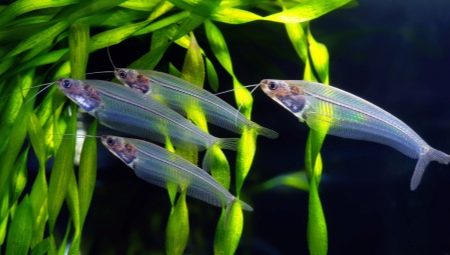
Glass species of underwater pets are very interesting and unusual. These fish are often kept in aquariums. In the article we will talk about one of them, namely, the glass Indian catfish.
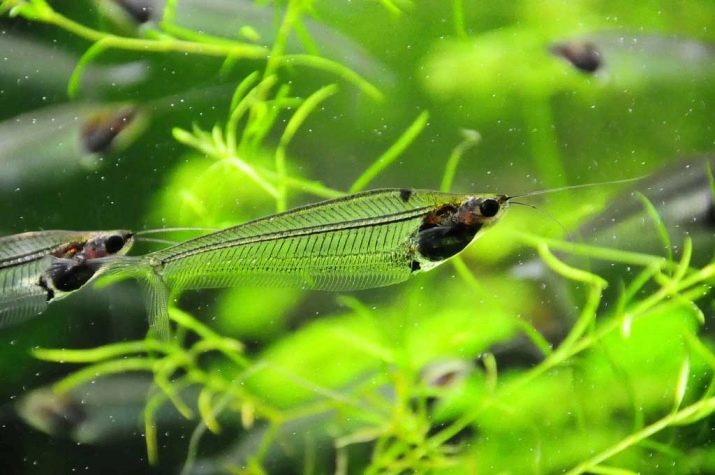
Peculiarities
The Indian glass catfish is also called the ghost catfish, the two-whined Indian catfish. The homeland of this species is Southeast Asia (Thailand, Indonesia, Java, Borneo, Sumatra). This catfish was brought to European countries in 1934, and it came to the USSR in 1964. The body of such a catfish is elongated, flat from the sides, very similar to a knife.
Immediately behind the head is a not very noticeable dorsal fin. These catfish have a long transparent anal fin. It starts from the head and ends at the very tail, has 58 rays. Like all catfish, there is a pair of short antennae on the head. They are very fond of this fish for its complete transparency - all internal organs and the spine are visible, as on an X-ray, but the most interesting thing is that background objects are visible through these individuals.
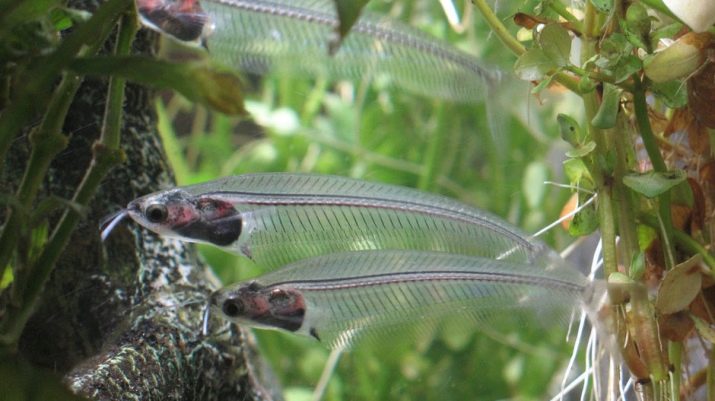
Thus, the name "ghost" is fully justified. This is due to the absence of pigments in their bodies. How and why this happened, no one can give an unambiguous answer. But their transparency does not mean a complete lack of color. With the right lighting, their bodies sparkle with a bright, metallic hue.
Catfish grow on average up to 10 cm. In aquariums they live up to 10 years. It is very difficult to distinguish a female from a male. It is believed that females are fatter than males.
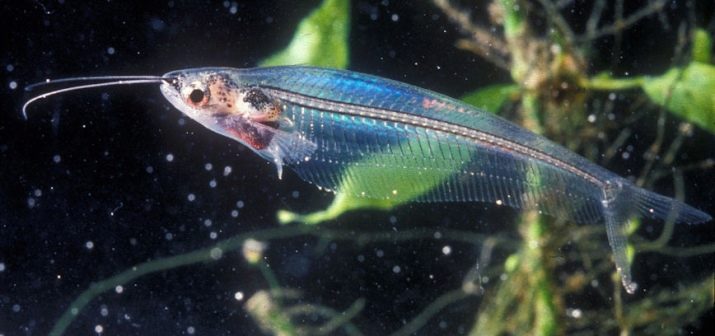
In nature, small flocks of glass catfish freeze, “looking” upward in water bodies with a weak current - this is a way of foraging for them. Habitual food of individuals:
- small worms;
- small larvae;
- zooplankton.
They will not pick up food from the bottom - this distinguishes them from other catfish.
During the rainy seasons, glass catfish migrate into the flooded thickets. They spawn there, and then return. This fish is gradually disappearing from nature due to man and his destructive effect on the natural habitat of the species. Strong pollution of water bodies is doing its job.
The water temperature for keeping them in the aquarium should be from +23 to +26 degrees Celsius, but below +25 is undesirable. Poorly tolerate a sharp change in water parameters. Moving into a new, unbalanced tank may not survive at all. Due to such fastidiousness and difficulty in leaving it is not recommended to keep this fish for beginners in the aquarium hobby.

How to contain?
The described fish is schooling and feels well in the composition of at least 7 individuals. In solitary keeping, the catfish will be subject to constant stress, may stop feeding and, as a result, die. For a flock of 7 individuals, a reservoir of 150 liters or more, necessarily equipped with good aeration and filtration, which creates a weak current, will be enough.
We must not forget on a regular weekly water change for fresh water in the amount of 20-25%, since such individuals are very sensitive to the presence of ammonia and nitrates in the liquid. Will not interfere and regular cleaning in the aquarium, and cleaning the bottom from waste products.
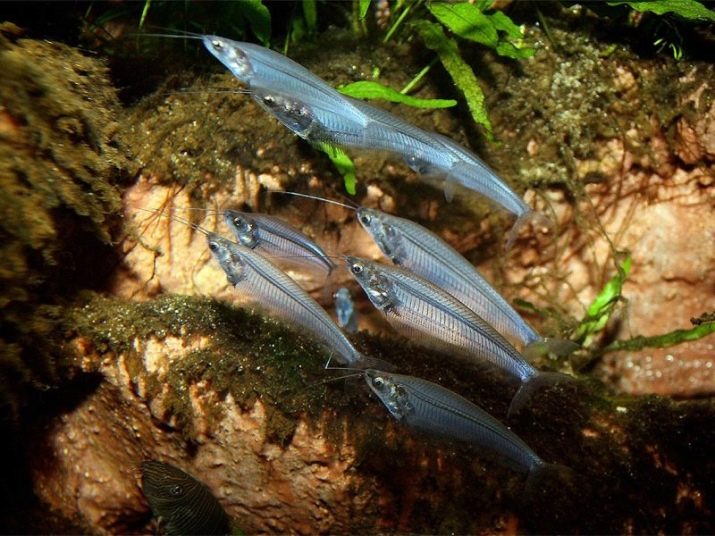
It is best to decorate the aquarium with a large number of living plants, in places to create shaded areas. Floating plants such as hornwort or mosses work well for this.
These fish are very unusual in behavior. In calm conditions, the flock freezes in one place and waits for food to appear. If the aquarium contains more than 30 individuals, then they are divided into 2 identical flocks.
Compatible with all peaceful fish species. The main thing is that there is a similarity in size with neighbors. Glass catfish are incompatible with any predatory fish. Even a whole flock will not be able to fight off an attacking hunter. The glass catfish themselves do not touch the neighbors in the aquarium, they can occasionally hunt the fry passing by.
They prefer live food, but you can gradually get used to dry food. Some aquarists are convinced that it is better to keep such fish in a "species" aquarium. There is no consensus on this matter, since an important role is played by the location of the tank in the house or apartment.
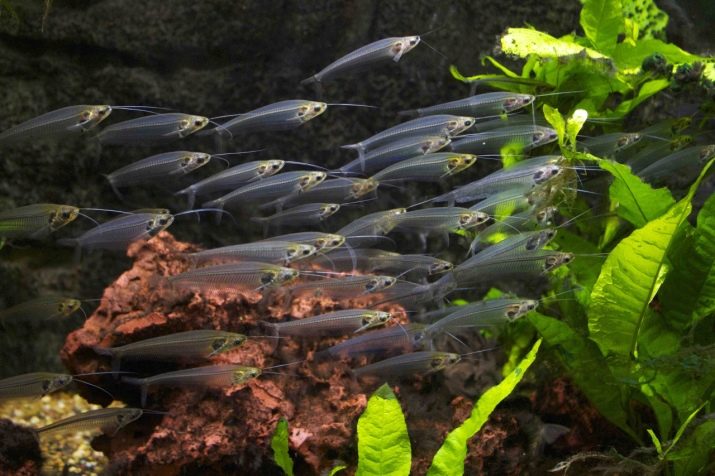
We must not forget that this fish is very shy, and stress is destructive for it. If the aquarium is located in a walk-through room or where someone constantly passes by the reservoir, the catfish will constantly be intimidated by the household.
With such an arrangement of the home reservoir, leaving it "species" would not be the best idea. For the Indian catfish, it will be a good anti-stress to have another peaceful, but less fearful fish in the neighborhood. By focusing on your aquarium neighbors, catfish will be less fearful and stress-prone.
And in the case when your reservoir is located in the far corner, and rarely anyone approaches it, then you can arrange a "species" reservoir. In this case, all the attention of the fish will be directed to finding food.
The main difficulty in feeding is that food should sink slowly right in front of catfish muzzles. This fish will not rush around the entire aquarium and catch it, and they will not rush to pick up food that has fallen to the bottom. It happens that neighbors do not allow these catfish to eat normally. In this case, you will have to give food right before turning off the lights, but again, you need to get food right in front of their muzzles.
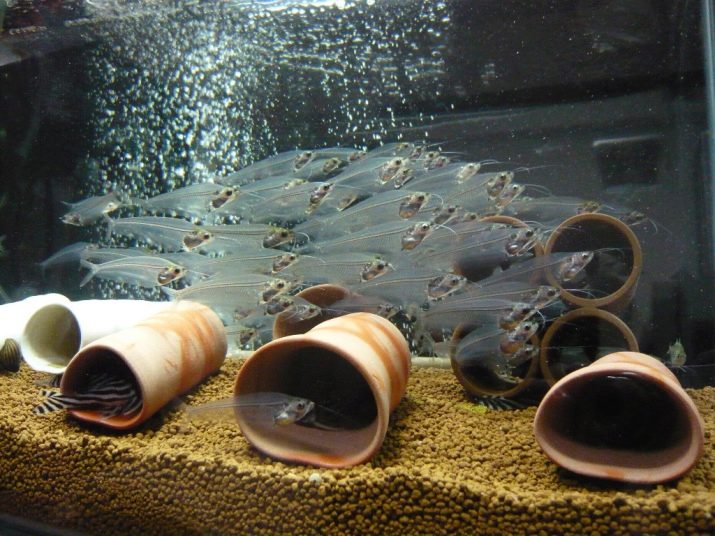
You can determine the health of the described fish by its appearance. If the catfish has lost transparency, this may mean that something is disturbed in the aquarium.... If you see a dimmed individual in front of you, there is very little time left for taking action before the fish dies.
Since all fish on the market are caught in the wild, they can carry various diseases and kill the rest of the fish in the aquarium. To avoid this, it is necessary to keep the pets in quarantine after purchase for at least 10 days.
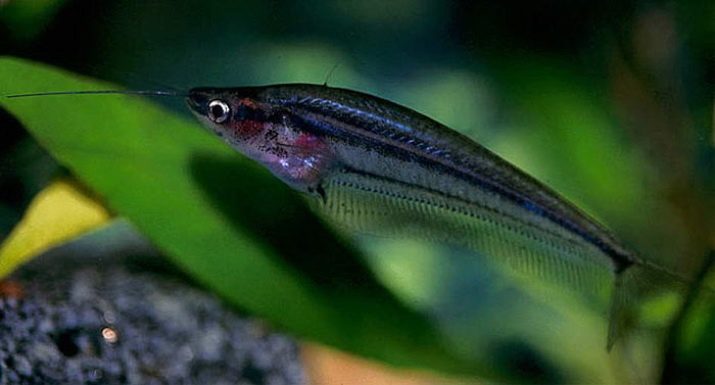
Breeding
These fish become capable of reproduction at the age of two years, but in a home reservoir this activity will be very difficult. All fish sold at pet stores are from the wild or farms of Southeast Asia. In the USSR, these fish were bred several times by Mikhail Timofeevich Likhachev from Moscow.
To stimulate spawning, it is necessary to observe several simple conditions that simulate the rainy season. This will require:
- lower the temperature by a couple of degrees;
- lower the water level;
- change water up to 25% for fresh water;
- poor lighting;
- cover the glasses with paper to make the fish less irritable.
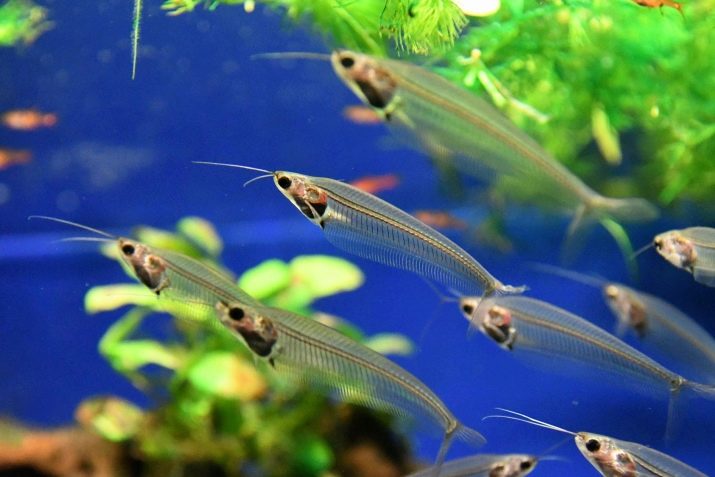
These fish spawn in a flock. One female sticks 100-200 not very sticky eggs to the substrate during spawning. They usually peel off and fall to the bottom. After the end of spawning, the parents are immediately removed from the spawning aquarium, and the temperature is raised to + 27.28 degrees. After about 3 days, the larvae appear, soon they will swim and begin to feed on their own.
After the fry began to feed, the temperature must be lowered to the values of the general aquarium. You need to feed babies 4 times a day with rotifers, ciliates, brine shrimp.
Useful Tips
There is a misconception that it is very easy to keep fish, and there is no science here. It's actually quite a complex, but mastered process. Learning how to work with water is essential for the proper maintenance and development of your aquarium pets. Would need learn how to regulate hardness and acidity, and also start the aquarium correctly.
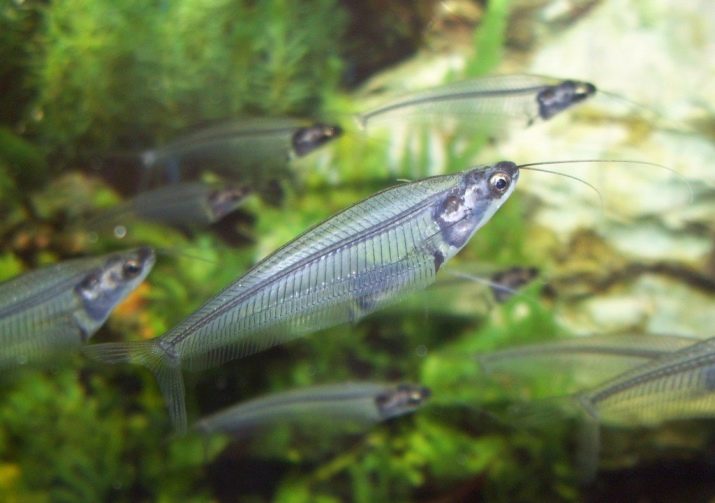
When cleaning and cleaning an aquarium in which glass catfish (and other species) live, the same mistake often occurs, which consists in washing the filter sponge. The sponge itself is a biofilter necessary for the balanced operation of the entire reservoir. It is home to colonies of beneficial bacteria that convert nitrates into less harmful substances.
Taking out a sponge from the aquarium, it is quite logical to wash it under running water until it is clean. This is the mistake - together with the "dirt", these beneficial bacteria are washed off, and a little chlorine from the water remains in the sponge. Placing such a sponge back, you risk upsetting the entire balance in the reservoir.
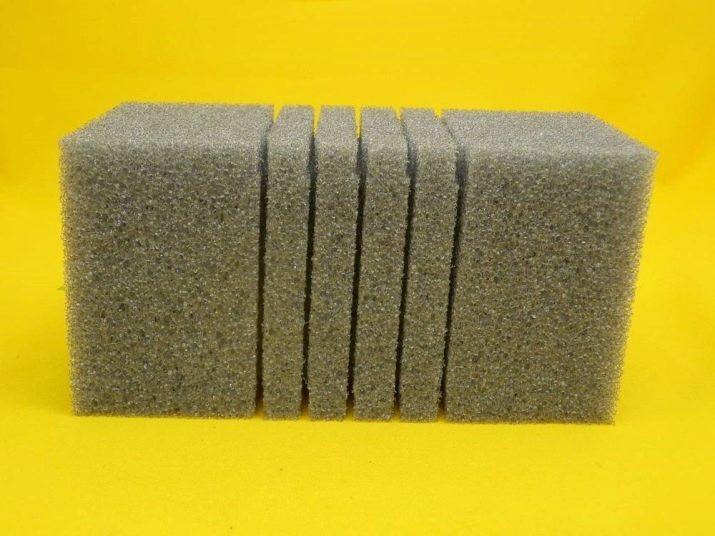
Glass catfish will not die after such cleaning, but this can negatively affect their health.
Do not use materials collected from the banks of rivers and seas as aquarium substrates and decorations. With them, you can bring various diseases to the aquarium. The best options for acquiring decorations, driftwood and stones would be specialized stores with tested and certified productsalready treated for pests and diseases. If you do decide to collect soil from the river bank for a catfish aquarium, you need to properly process it.
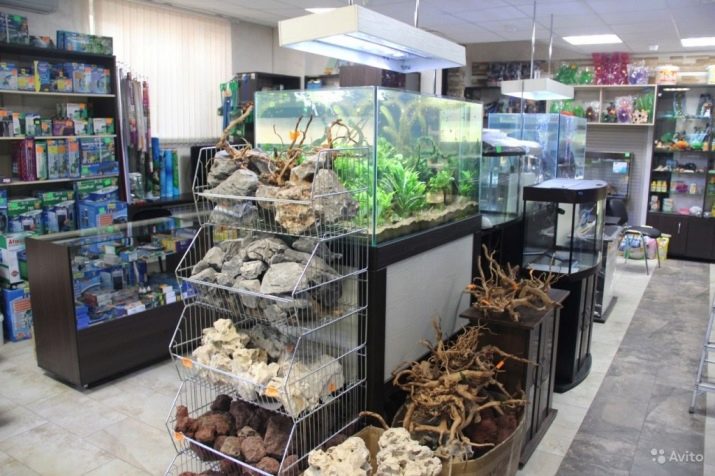
There are many different ways to disinfect soil at home. For this, various methods and preparations are used. This process can take a week or more. Let's consider one of the simplest and most common types of soil disinfection for an aquarium:
- the collected soil is thoroughly washed under running water to wash out branches, debris and light fractions;
- then it is poured into a metal container for subsequent boiling;
- 300 g of salt is poured into 1 liter of water, the soil must be completely submerged under water;
- the collected material is boiled for at least 5 hours, if necessary, add water;
- after boiling, let the water cool down, then drain the saline solution, and again thoroughly rinse the soil under running water;
- now it is necessary to remove the remaining salt from the soil, for this we pour the full container in which the soil is located with ordinary tap water and leave it to settle for at least 5 days, changing 100% of the water to fresh water every day;
- after the time has elapsed, fill the soil into the aquarium, but do not populate the inhabitants - this material must be properly filtered for at least a day.
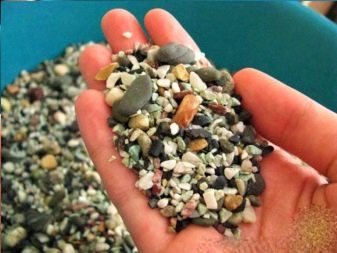
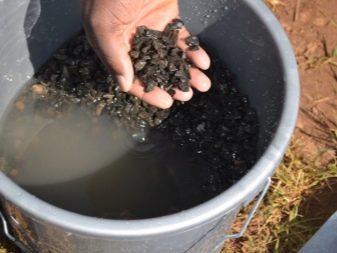
After such a long procedure, the likelihood of illness and death of glass catfish will be minimal.
For the features of the glass catfish, see the video below.








